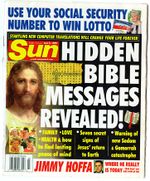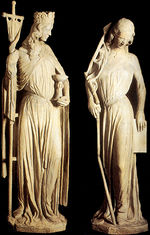Category:Letter of Barnabas (text)
The Letter of Barnabas is an early Christian document, included in collections of Apostolic Fathers.
- See Online Text
Major topics in the Letter
Allegorical interpretation
"Abraham, the first to perform circumcision was looking ahead in the Spirit to Jesus when he circumcised. For he received the firm teachings of the three letters. For it says: Abraham circumcised eighteen and three hundred men from his household [Gen 14:14; 17:23]… Notice that first he mentions the eighteen and then, after a pause, the three hundred. The number eighteen [in Greek] consists of an Iota [J], ten, and an Eta [E], eight. There you have Jesus [JEsous]. And because the cross was about to have grace in the letter Tau [T], he next gives the three hundred, Tau. And so he shows the name Jesus by the first two letters and the cross by the other" (Barnabas 9:6-8).
See Bible Code
Allegorical reading vs. literary reading
The allegorical interpretation of the Bible was common among Hellenistic Jews (see Letter of Aristeas, Philo of Alexandria). The Letter of Barnabas now claims that the allegorical interpretation makes the Mosaic Torah obsolete. Those who understand the "true" meaning of Scripture (i.e. the Christians) do no longer need to obey the letter of the Law. In contrast, those who still follow the Law (i.e. the other Jews) are attached to an inferior form of knowledge.
- “The commandment of God is not a matter of avoiding food; but Moses spoke in the spirit. This is why he spoke about the pig: Do not cling – he says – to such people, who are like pigs… who live in luxury and forget the Lord, but when they are in need they remember the Lord. This is just like the pig: when it is eating, it does not know its master, but when hungry, it cries out… Do not eat the hare… You must not be one who corrupts children or be like such people. For the rabbit adds an orifice every year; it has as many holes as years it has lived… Moses received teachings about food and spoke in the spirit. But they [the Jews] received his words according to the desires of their own flesh, as if he were actually speaking about food…” (Barnabas 10:1-9).
Christianity vs. Judaism
Some people are wrong “saying that the covenant is both theirs and ours. For it is ours. They (the Jews) permanently lost it…Their covenant was smashed—that the covenant of his beloved, Jesus, might be sealed in our hearts, in the hope brought by faith in him” (4:6-7,10). “They violated [God’s] Law, because an evil angel instructed them...” (9:4).
See Antisemitism
External links
- Wikipedia --
Pages in category "Letter of Barnabas (text)"
The following 13 pages are in this category, out of 13 total.
1
- The Famous Epistles of Saint Polycarp and Saint Ignatius... with the Epistle of St. Barnabas (1668 Elborow), book
- Sancti Barnabæ Apostoli Epistola Catholica (1685 Fell, Bernard), book
- Barnabae Epistula (1866 Hilgenfeld), book
- A Dissertation on the Epistle of S. Barnabas (1877 Cunningham), book
- De brief van Barnabas (1901 Veldhuizen), book
- Der Einfluss Philos auf die älteste christliche Exegese (Barnabas, Justin und Clemens von Alexandria) (1908 Heinisch), book
- Barnabas, Hermas and the Didache (1920 Robinson), book
- Barnabas and the Didache (1965 Kraft), book
- Épître de Barnabé (1971 Kraft & Prigent), book
- The Epistle of Barnabas: Outlook and Background (1994 Paget), book
- The Struggle for Scripture and Covenant: The Epistle of Barnabas and Jewish-Christian Competition in the Second Century (1996 Hvalvik), book
Media in category "Letter of Barnabas (text)"
The following 3 files are in this category, out of 3 total.
- 1912 * Lake.jpg 304 × 475; 28 KB
- 1964-E * Grant.jpg 907 × 1,360; 189 KB
- 2003 * Ehrman 3.jpg 947 × 1,417; 189 KB




